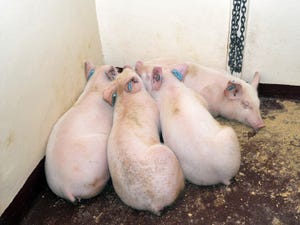Are antibiotic residues present in DDGS?
Of the total responses received, 14 of the 19 (73.7%) ethanol producers reported that they regularly use antibiotics on a preventative basis.
September 20, 2018

By Jerry Shurson, Audrey Walter and Pedro Urriola, University of Minnesota Department of Animal Science
About 6 million metric tons of corn distillers dried grains with solubles are used in U.S. swine diets annually because of its high nutritional and economic value. During the production process, low doses of antibiotics are frequently used to prevent and control bacterial contamination that reduces ethanol yield. Virginiamycin and penicillin G are the two most common antibiotics used in ethanol production, and have been determined to be Generally Recognized As Safe by the U.S. Food and Drug Administration for dosing in the fermentation stage up to 3.0 ppm.
Although this dose concentration is 5 to 37-fold less than previous FDA approvals for using virginiamycin in swine feeds, this practice has led to questions about the potential risk of antibiotic residues being present in DDGS, their effects on feed and food safety and potential contributions toward developing antibiotic resistant bacteria. However, previous DDGS surveys have shown that ethanol production facilities have used other antibiotics, such as erythromycin, which is of medical importance.
Results from our previous survey conducted in 2011 showed that 12.6% of wet and dried distillers grains samples collected from 43 ethanol facilities located in nine states (samples were collected on a quarterly basis) contained low concentrations (< 1.12 ppm) of antibiotic residues (Paulus-Compart et al., 2013). Specifically, 8.8% of these samples contained detectable concentrations of erythromycin, 1.3% of the samples contained penicillin residues, and 0.6% of the samples contained biologically active virginiamycin residues. However, with the implementation of the Food Safety and Modernization Act in 2011, and the increased demand for antibiotic-free DDGS, we hypothesized that the prevalence and concentrations of antibiotic residues in DDGS is less in the current market than previously reported.
With the assistance of CHS Inc. (Inver Grove Heights, Minn.), we conducted a new survey where we collected samples from 20 ethanol production facilities located in nine states, and analyzed them for the presence of biologically active virginiamycin residues (Phibro EPG, St. Paul, Minn.), as well as chemical concentrations of penicillin G, chlortetracycline and erythromycin residues (SGS North America Inc., Brooking, S.D.). We also obtained information from these facilities regarding their antibiotic use practices.
We received detailed information about antibiotic use from 19 of the 20 ethanol plants participating in this survey. Of the total responses received, 14 of the 19 (73.7%) ethanol producers reported that they regularly use antibiotics on a preventative basis. Additionally, 12 producers (85.7%) reported that they use a combination of virginiamycin and penicillin in both propagation and fermentation stages (78.6%) of ethanol and co-product production. Only one producer reported the use of erythromycin in their antibiotic combination, and only two producers (14.3%) reported using only virginiamycin. Additionally, one producer reported using natural hops extract as a non-antibiotic alternative.
Although most ethanol producers use a combination of penicillin G and virginiamycin in the production of co-products, there were no detectable concentrations of penicillin G or biologically active virginiamycin residues in the 20 DDGS samples. These observations suggest that these antibiotics are being used appropriately to avoid the presence of detectable residues in DDGS. Furthermore, as shown in previous surveys, no detectable tetracycline residues were present in the 20 DDGS samples collected. However, one sample (5.0 %) contained erythromycin residue (2.11 milligrams per kilogram).
While the prevalence of erythromycin residues in this recent survey is less than reported in our previous survey conducted seven years ago (Paulus-Compart et al., 2013), the concentration of the erythromycin residue in our current survey was greater than the average concentration (0.35 ppm) of erythromycin residues observed in our previous survey. Therefore, continued efforts should be directed toward eliminating the use of erythromycin in the ethanol industry because of the recurring presence of erythromycin residues in DDGS samples in multiple surveys, its lack of GRAS approval for use in ethanol production, its classification as a medically important antibiotic for humans and its potential contribution to the development of bacterial resistance.
Conclusion
Although the number of samples in this survey was limited, it appears that the risk of antibiotic residues being present in DDGS in the current market is very low compared with results reported in previous surveys. However, the ethanol industry needs to use only GRAS approved antibiotics at approved dosages and eliminate the use of erythromycin to avoid the risk of residues in DDGS.
Reference
Paulus-Compart, D.M., Carlson, A.M., Crawford, G.I., Fink, R.C., Diez-Gonzalez, F., DiCostanzo, A., Shurson, G.C., 2013. Presence and biological activity of antibiotics used in fuel ethanol and corn co-product production. J. Anim. Sci. 91, 2395–2404. doi.org/10.2527/jas.2012-5714
You May Also Like



